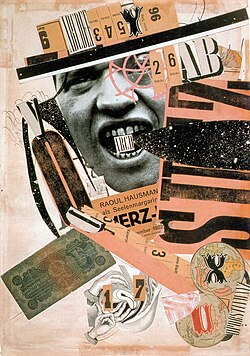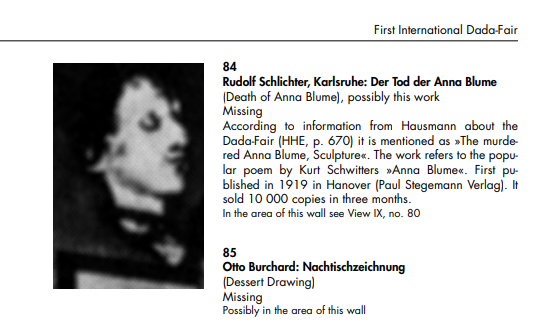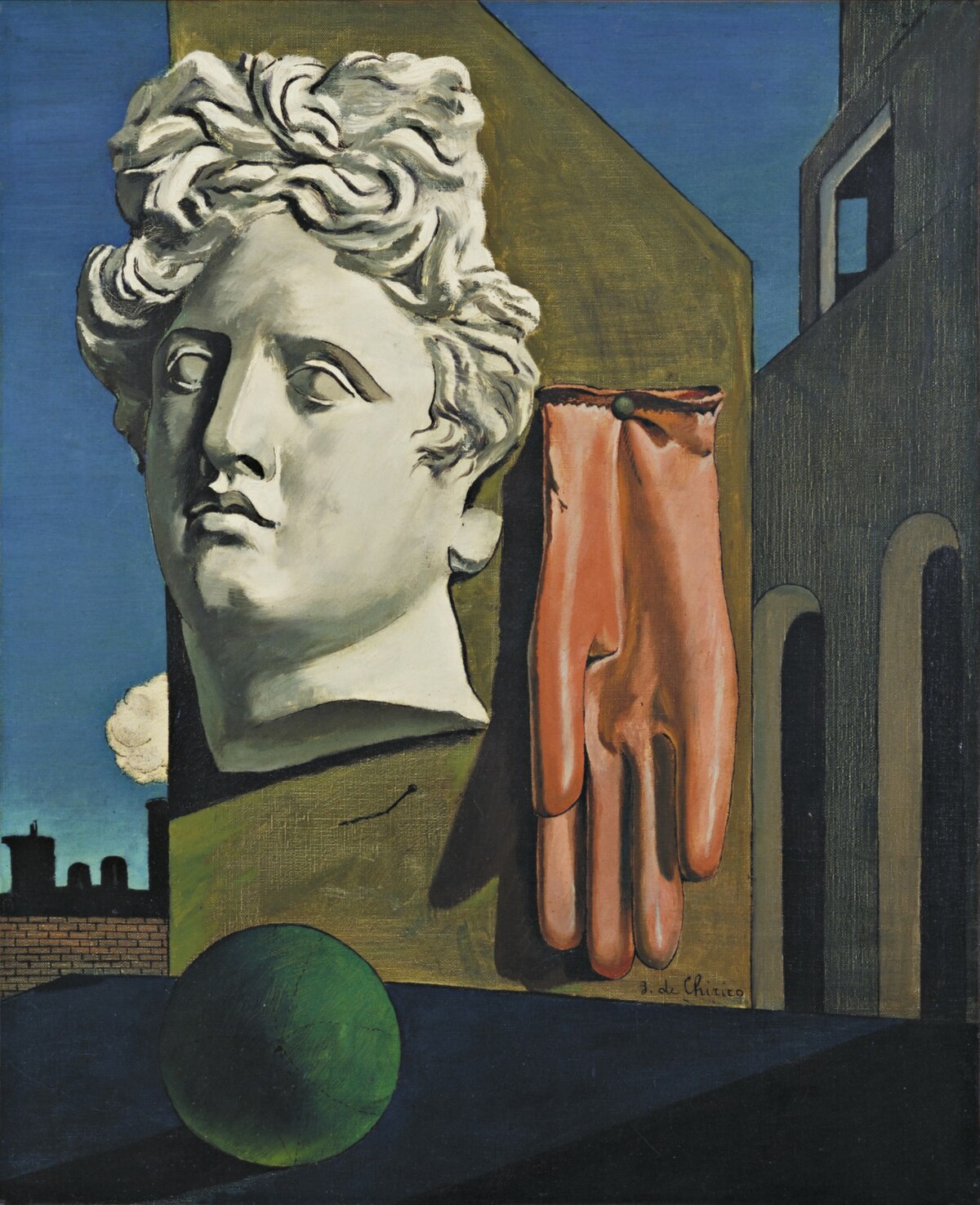created 2025-05-05, & modified, =this.modified
rel: Dada - Art and Anti-Art Dada Surrealism and their Heritage by William Rubin
Why I’m reading
I’ve read this a few times but not taken full notes. I heard it’s one of the best, and most comprehensive from the chief curator of the painting and sculpture collection at Museum of Modern Art NYC.
I have the physical copy.
Dada
Dad was born on the eve of the First World War. Surrealism died, but was not interred, in the wake of the Second.
Tristan Tzara - The beginnings of Dada were not the beginnings of art, but of disgust.
The origin of the name is almost instantly unclear, but the movement existed before the name did.
It’s miscategorized as a negative movement, because of its aim at subverting the modern bourgeois society. But it fostered real contributions in art, poetry music and politics.
Dadaists called for a tabula rasa.
But besides the Germans where Huelsenbeck, Baargeld and others became active Communists, Dada centered on isolated, individual gestures and failed to be systematized; the need for binding was one of the calls of the formation of the successive Surrealist movement.
Duchamp on putting art back into the mind/ideas, rather that visual products.
I wanted to put painting once again at the service of the mind. And my painting was, of course, at once regarded as “‘intellectual,”’ ‘‘literary’’ painting. It was true I was endeavoring to establish myself as far as possible from “‘pleasing’’ and ‘“‘attractive’’ physical paintings… . The more sensual appeal a painting provided—the more animal it became—the more highly it was regarded?
The Dadaist considers it necessary to come out against art because he has seen through its fraud as a moral safety valve.
Duchamp’s readymade the bottle rack was stated by Robert Motherwell, as one of the most beautiful sculptures of the year 1914. This is ironic because beauty was the last thing Duchamp was after.
“It is also,’ Motherwell continues, “a subtle solution to an essential Dada dilemma, how to express oneself without art when all means of expression are potentially artistic.”’
After his Cubist-Futurist formulations Duchamp went on to his “machine style”: the creation of ambiguous “being-machines” with forms of pseudomechanical nature.
Schwitter’s stood in opposition of the early dadaist anti-art. For him art was “a primordial concept” and “merz aims only at art.”
Post-Cubist Morphology
The adoption of biomorphism marked the transition of Miro and Masson from Cubism to Surrealism.
The subject ‘which was the artist’s starting point (a woman with a guitar in the case of Ma Jolie) makes little difference in the advanced Cubist picture of 1911-12 owing to the extreme to which the process of abstraction and reorganization is carried. All subjects, whether inherently architectural or not, end as architecture.
Verticality and horizontality are not so much the properties of man as of the manmade world, the environment that man creates in order to function with maximum stability. The Cubist picture speaks of this external world—one that man constructs and upon which he meditates—abstractly, from a position once removed.
The Paintings of Duchamp
…and retiring to a life of chess, punctuated occasionally by the creation of ironic “machines’’ and by other forms of Dada activity, Duchamp became a living myth, the personification of Dada’s refusal to distinguish be- tween art and life.
Sad Young Man in a Train
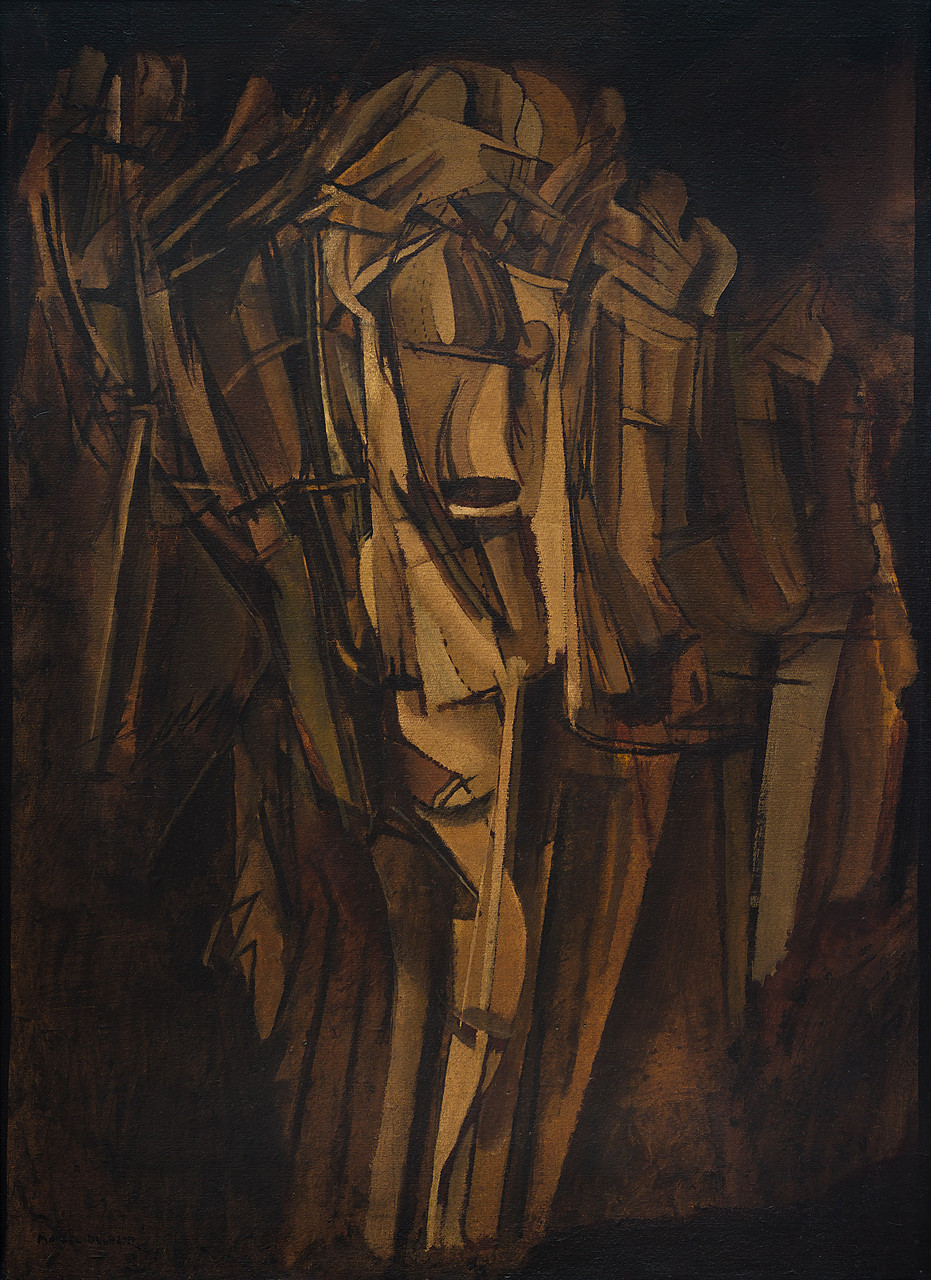
The nude as an unencumbered machine.
Gabrielle Buffet-Picabia:
It seems incomprehensible to the present generation that the machines which populate the visual world with surprising and spectacular forms, hitherto unknown, could for a long time have remained the victims of a frenzied ostracism in the official world of the arts, and that they could have been looked upon as essentially antiplastic, both in substance and in function. I remember a time when their rapid proliferation passed as a calamity. … The discovery and rehabilitation of these strange personages of iron and steel, which radically distinguished themselves from the familiar aspects of nature, both by their construction and by the dynamism inherent in the automatic movements they engendered, was in itself a bold, revolutionary act; but one which, if it had not gone beyond descriptive representation, would have remained very close to the landscape and the still-life. Yet, first enthroned for their own sake, the machines soon generated propositions which evaded all tradition, above all a mobile, extra-human plasticity which was absolutely new. .. . The multiple possibilities which this unexplored field offered to the imagination seem to have shown Duchamp his true mission. Or perhaps he created for his own personal use an imaginary mechanical world, which became the place, the climate, the substance of his works.*
Shadows: “Duchamp explains very simply that if a shadow is a two-dimensional projection of a three-dimensional form, then a three-dimensional object must itself be the projection of a four-dimensional form.”
The Bride:
Duchamp underwent a profound intellectual crisis, which resulted in his renunciation of oil painting and his adoption at the same time of a more mechanistic, pseudoscientific, verbally inspired imagery.
Why Not Sneeze Rose Sélavy? , a birdcage filled with cubes of sugar, into which a thermometer and cuttlebone have been thrust.
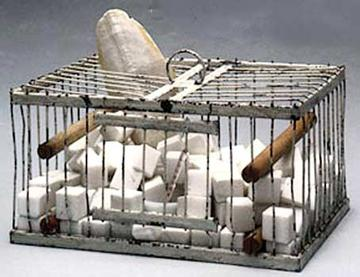
They consist of a birdcage, 152 white cubes (resembling sugar cubes, but made of marble), a medical thermometer, a piece of cuttlebone, and a tiny porcelain dish. The birdcage is made of painted metal and contains several wooden perches.
Duchamp said “it’s a readymade in which sugar is changed to marble. It’ is a sort of mythological effect.” Breton:
“I have in mind the occasion when Marcel Duchamp got hold of some friends to show them a cage which seemed to have no birds in it, but to be half-full of lumps of sugar. He asked them to lift the cage and they were surprised at its heaviness. What they had taken for lumps of sugar were really small lumps of marble which at great expense Duchamp had had sawn up specially for the purpose. The trick in my opinion is no worse than any other, and I would even say that it is worth nearly all the tricks of art put together.”
He selected the objects of his readymades by visual indifference, complete anesthesia. Good or bad taste were never dictating it.
Tu m’ was a summary of painting at the moment of his farewell to it. It is his last painting on canvas. The title lends a sarcastic tone to the work, for the words, perhaps short for the French “tu m’emmerdes” (you annoy me) or “tu m’ennuies” (you bore me), seem to express his attitude toward painting as he was casting it aside.
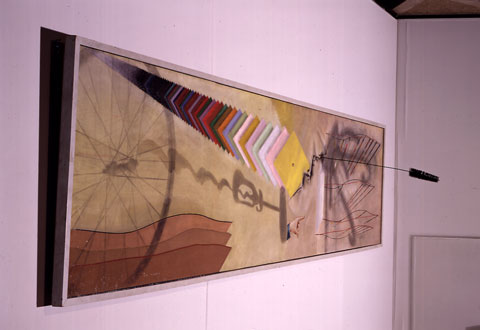
The superimposed color samples in the upper left not only allude to color theory but in their overlapping and diminution demonstrate two ways of representing space. The cast shadow is introduced in the form of pencil tracings of the actual shadows projected by three Readymades (left to right: Bicycle Wheel, Corkscrew, and Hat Rack), which also show the shadows as direct projection (wheel), distorted projection (cork- screw), and vague or diffused projection (hat rack).
Thought
Oh my god, I’ve seen this in person and there it is – plain as day a manicule.
The little sign painter’s hand seems to be pointing out a lesson in it, in much the same way that didactic points are literally indicated in old religious paintings.
Picabia’s Optophone:
Optophone I, below, is composed of lines that might be sound waves, with a pattern that disorders vision.
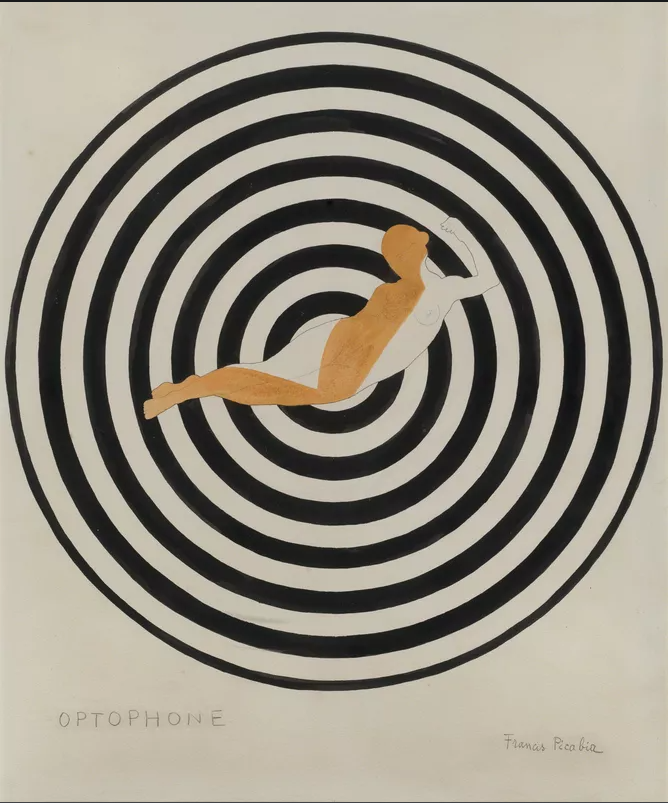
Thought
I’m only just returning to this entry after an insane chain of digression → A-2 and on and on. If I hadn’t made note I’m not sure I would even have known where I started (if this was indeed the start).
Tristian Tzara Accidental Poem:
To make a dadaist poem Take a newspaper. Take a pair of scissors. Choose an article as long as you are planning to make your poem. Cut out the article. Then cut out each of the words that make up this article and put them in a bag. Shake it gently. Then take out the scraps one after the other in the order in which they left the bag. Copy conscientiously. The poem will be like you. And here you are a writer, infinitely original and endowed with a sensibility that is charming though beyond the understanding of the vulgar.
Fit for Active Service by George Grosz
A work of New Objectivity which was a German reaction against expressionism.
*Sachlichkeit should be understood by its root, Sache, meaning “thing”, “fact”, “subject”, or “object.” Sachlich could be best understood as “factual”, “matter-of-fact”, “impartial”, “practical”, or “precise”; Sachlichkeit is the noun form of the adjective/adverb and usually implies “matter-of-factness”.
It depicts a bare skeleton being judged as physical fit for conscription by a military doctor.
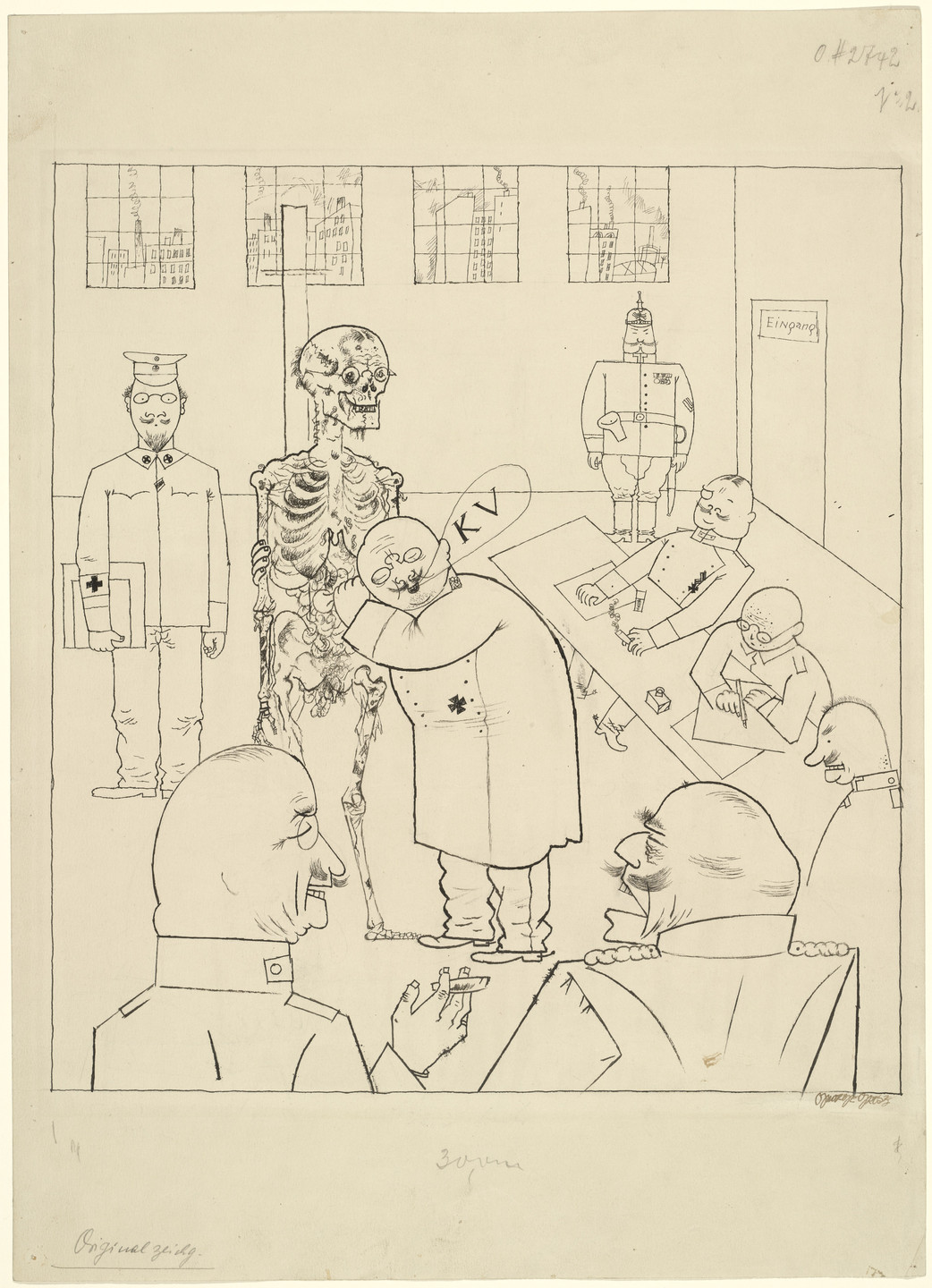
Grosz was drafted by the German military during WWI, but was able to avoid conscription after being deemed unfit for duty. He was sent to an insane asylum where he was examined by doctors and judged as fit. He was later discharged after attempting suicide.
He spelt his name with the terminal e in the English manner, out of sheer anti-nationalist feeling.
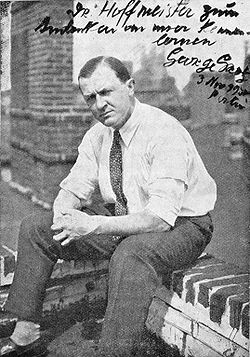
Of course, there was a kind of mass enthusiasm at the start. But this intoxication soon evaporated, leaving a huge vacuum… And then after a few years when everything bogged down, when we were defeated, when everything went to pieces, all that remained at least for me and most of my friends, were disgust and horror.
Some quotes:
I am lonely without measure; that is to say, I am alone with my doubles, phantasms in whom I realize specific dreams, ideas, inclinations, and so on. I rip three other people out of my inner life, give them names, and believe in them myself. Gradually three clearly defined types have emerged: 1: Grosz. 2: Count Ehrenfried, the nonchalant aristocrat with the well-manicured fingernails, concerned only with cultivating himself; in a word, the detached, aristocratic individualist. 3: The physician. Dr. William King Thomas, the more American, practical counterweight to Grosz the mother figure.
Árt is dead. Long live Tatlin’s new machine art.
On him:
”This cynic is a secret moralist. Negation is merely his manner of speaking; what he really.. ..loves is the positive. One might think: one little push, and he would he painting pictures full of ecstasy and mysticism. It is his personal bad luck that he is condemned to be a caricaturist. In any case he is never going to be a humorist like Wilhelm Busch, one of the comfortable kind. There is no telling that he will become. For the time being we recall the old saying that yes and no are very close neighbors, in life and in art.” - Ludwig Coellen
Collage
Late in 1918, Hausmann hit upon the idea of the photographic collage, which was partly suggested by a trick of the German army photographers, who had made oleolithographed mounts, from which the faces were cut out, showing groups of soldiers in idealized set- tings. In these mounts they inserted the photographed faces of their clients, often unifying the whole by tinting it.
Dadamax Ernst
No painter has more completely personified the interwar avant-garde than Max Ernst.
“Though he invented many things, he has never bothered to exploit any of them”
On Automatic techniques favored by Surrealists and Dadaists he spoke as a spectator at the birth of his own paintings, an instrument recording,
ce qui se voyait en moi - what was visible within me.
He considers his paintings less an esthetic statement toward a spectator than the diary of a philosopher striving for maximum consciousness.
He worked on collage, his collages were often made without gluing elements together. Collages in his own definition were a superimposition of images.
*One rainy day in 1919 in a town on the Rhine, my excited gaze is provoked by the images of a printed catalogue. The advertisements illustrate objects relating to anthropological, microscopal, psychological, mineralogical and paleontological research. Here I discover the elements of figuration so remote that its very absurdity provokes in me a sudden intensification of my faculties of sight – a hallucinatory succession of contradictory images, double, triple, multiple, superimposed upon each other with persistence and rapidity characteristic of amorous memories and visions of somnolescence. These images, in turn, provoke new planes of understanding. They encounter an unknown – new and non-conformist. By simply painting or drawing, it suffices to add to the illustrations a color, a line, a landscape foreign to the objects represented—a desert, a sky, a geological a, a floor, a single straight horizontal expressing the horizon, and so forth. These changes, no more than docile reproductions of what is within me, record a faithful and fixed image of my hallucination. They transform the banal pages of advertisement into dramas which reveal my most secret desires.
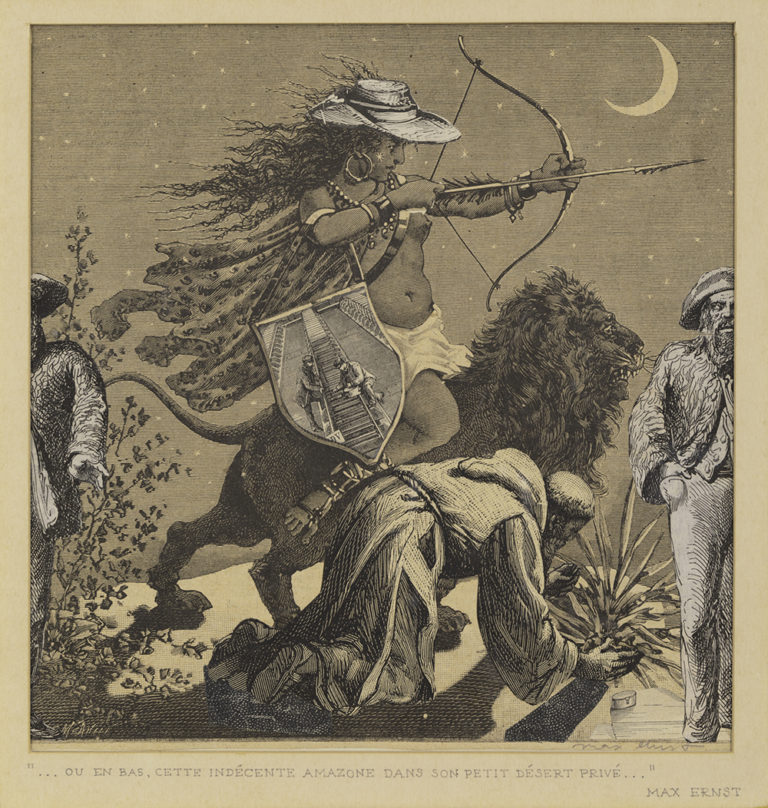
Titles are important elements of Ernst’s collages. Almost all are long and written in awkward print above, below and sometimes on the collage.
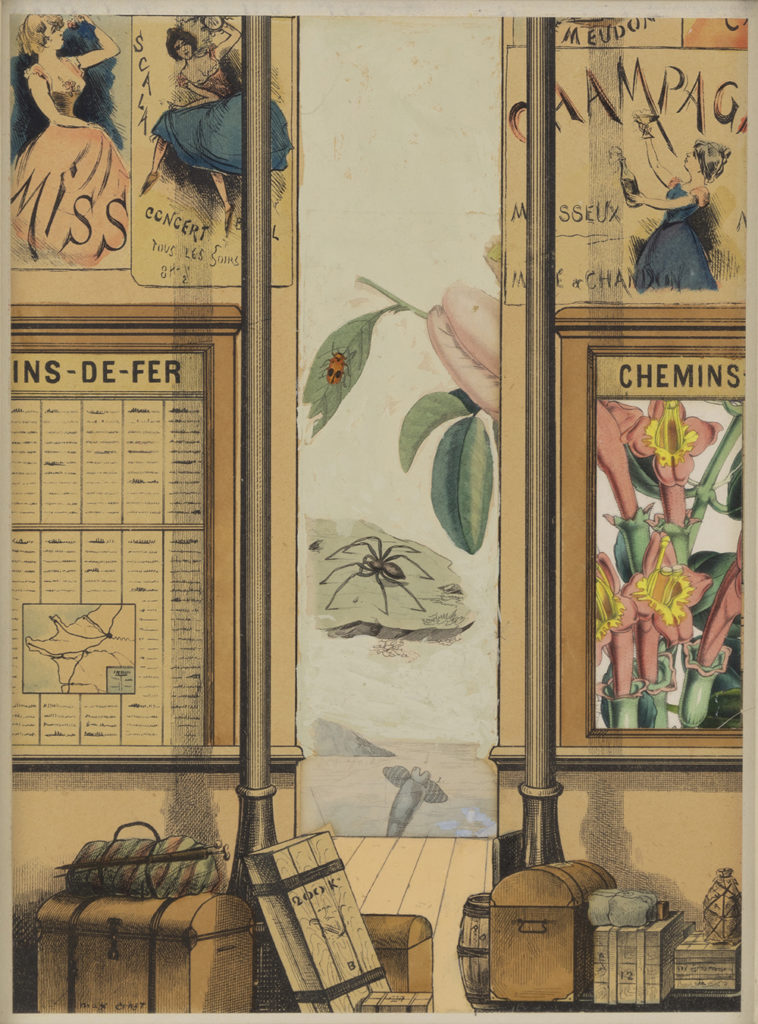
Kurt Schwitters
rel: In Search of Lost Art - Schwitter’s Merzbau
Schwitters was a synthesist, concerned with fusing the viable elements of Dad with formal tradition of Cubism. He devised a personal form of Dada called Merz. Merzbau, an improvisational, autobiographical esthetic environment contained the germs of important ideas explored by artists after WWII.
Combining poetry and painting:
For Schwitters the union of painting and poetry could start from either pole. ‘‘First I combined individual categories of art. I pasted words and sentences into poems in such a way as to produce a rhythmic design. Reversing the process, I pasted up pictures and drawings so that sentences could be read in them.’’
Merz Blue Bird - er wnd sie = “he and she” cut from different sources.
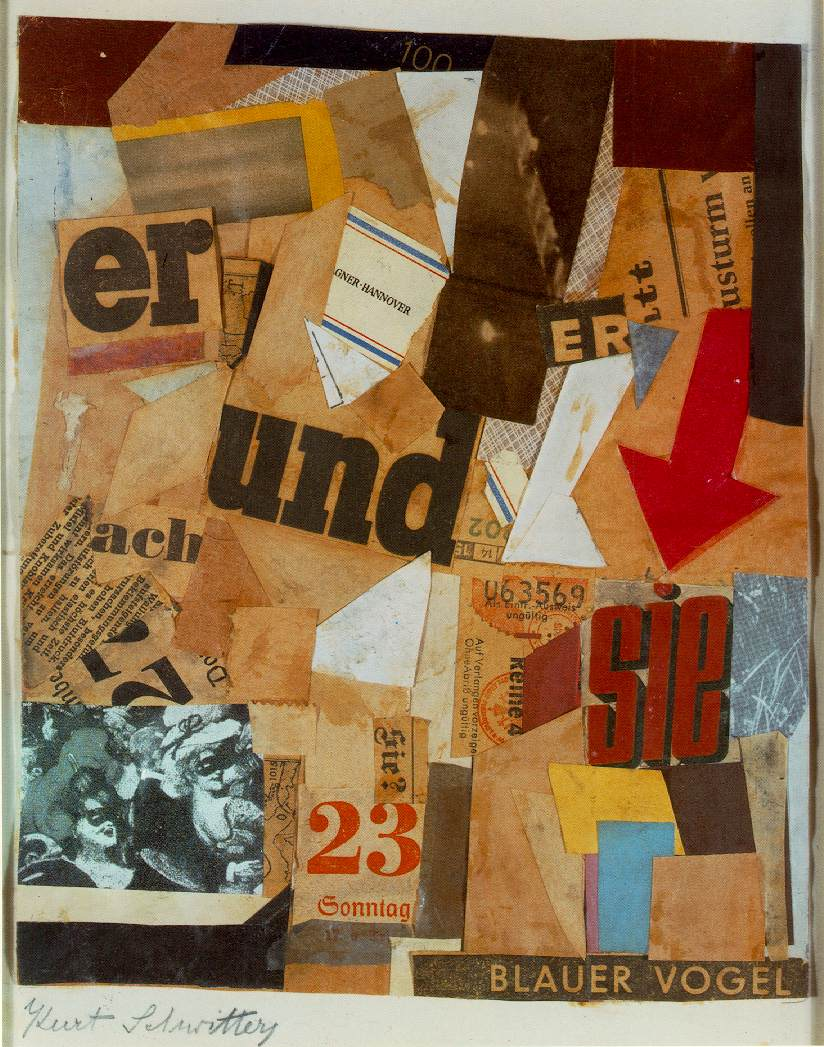
In the bottom-right margin is the title Blaze Bird, and to the left of it part of a page from a desk calendar marked “‘Sunday, 23rd.” A train ticket, a theater stub, and the fragment of a letterhead containing the name of the city of Hanover fill out the novelistic “iconography” of the ensemble. Among the other elements we might relate to the theme are the letters a-c-h cut from a larger word, forming the German word for ‘‘Ah!,” and the word Sturm (“‘storm’’), which has a particularly romantic meaning in German (and alludes also to Walden’s gallery).
An Anna Blume
“An Anna Blume” (“To Anna Flower” also translated as “To Eve Blossom”) is a poem written by the German artist Kurt Schwitters in 1919. It has been described as a parody of a love poem, an emblem of the chaos and madness of the era, and as a harbinger of a new poetic language.
Kurt Schwitters - “Elements of poetry are letters, syllables, words, sentences. Poetry arises from the interaction of those elements. Meaning is important only if it employed as one such factor. I play off sense against nonsense. I prefer nonsense, but that is a purely personal matter.”
The poem had a publicity campaign. Fly-posted all over Hanover were the words, “Who really is Anna Blume?” answered with “Twited brain! He painted the image of the time an didn’t know it. Now he kneels before the daisies and prays. ”
Richard Huelsenbeck found it offensively sentimental and romantic:
“Dada rejects emphatically and as a matter of principle works like the famous ‘Anna Blume’ of Kurt Schwitters.”
Berlin Dada into responding by exhibiting the effigy The Death Of Anna Blume, by Rudolf Schlichter at the First International Dada Fair, Berlin 1920
Anna Blume
O you, beloved of my twenty-seven senses, I
love your!
You your thee thine, I your, you mine. -- we?
This (by the way) is beside the point.
Who are you, uncounted woman? you are
-- are you? People say you are, -- let
them say it, they don't know how it stands with us.
You wear your head on your feet and walk about
on your hands, on your hands you walk.
Halloo your red dress, sliced in white pleats.
Red I love Anna Blume, red I love your! -- You
your thee thine, I your, you mine. -- we?
This belongs (by the way) out in the cold.
Red bloom, red Anna Blume, what do people say?
Prize question: 1. Anna Blume has a screw loose.
2. Anna Blume is red.
3. What color is the screw?
Blue is the colour of your yellow hair.
Red is the thread of your green screw.
You simple girl in simple dress, you dear
green animal. I love your! you your thee thine, I
your, you mine. -- we?
This belongs (by the way) in the ashcan.
Anna Blume! Anna, a-n-n-a, I trickle your
name. Your name drips like soft tallow.
Do you know it, Anna, do you know already?
You can be read from behind, and you, you
loveliest of all, you are from behind as you are
from the front: "a-n-n-a."
Tallow trickles softly over my back.
Anna Blume, you trickle beast, I love your!
Merzbau
Out of an overflow of collages and reliefs, his floors became crowded with objects – “a personal museum” called Merzbau (Merz structure). It evolved from the Dadaist tradition of blending art and life.
The distinction between the reliefs as independent entities and the walls as backdrops for any interesting junk that Schwitters happened to find soon disappeared. At the same time, the piles of free-standing junk grew constantly,
The center of the house began to be surrounded by a stalactite growth of wood and plaster, “a sculpture built from inside around you” which in time extended through two floors of the building down into a cistern. The personal inner core made a kind of grotto part of which was only accessible through doors and windows in the timber structure.
Among the names Schwitters gave to sections of the Merzbau were Nibelungen Treasure, Cathedral of Erotic Misery, Goethe Grotto, Great Grotto of Love, Lavatory Attendant of Life; there was also a Sex-Murder Cave, which contained a red-stained broken plaster cast of a female nude
Gesamtkunstmerz
It was not a synthesis of genres, but a confusion of them. His total Merz-stage. Schwitters:
Take gigantic surfaces, conceived of as infinite loak them in color, shift them menacingly… . Paste smoothing surfaces over one another… . Make lines fight together and caress one another in generous tenderness… Bend the lines, crack and smash angles… let a line rush by, tangible in wire… . Then take wheels and axles, hurl them up and make them sing (mighty erections of aquatic giants). Axles dance mid-wheel roll globes barrel. Cogs flair teeth, find a sewing machine that yawns. … Take a dentist’s drill, a meat-grinder, a car-track scraper, take buses and pleasure cars, bicycles, tandems and their tires, also war-time ersatz tires and deform them. .. . Take petticoats and other kindred articles, shoes and false hair, also ice-skates and throw them into place where they belong, and always at the right time… . Inner tubes are highly recommended. Take in short everything from the hairnet of the high class lady to the propeller of the S.S. Leviathan, always bearing in mind the dimensions required by the work. >Even people can be used.. >Now begin to wed your materials to one another. For example, you marry the oilcloth table cover to the home owners’ loan association, you bring the lamp cleaner into a relationship with the marriage between >Anna Blume and A-natural, concert pitch… . You make a human walk on his (her) hands and wear a hat on his (her) feet… . A splashing of foam. And now begins the fire of musical saturation. Organs backstage sing and say ‘‘Futt, futt.’” The sewing machine rattles along in the lead. A man in the wings says: “Bah.” Another suddenly enters and says: “I am stupid.” (All rights reserved.) Between them a clergyman kneels upside down, cries out, and prays in a loud voice: “Oh mercy seethe and swarm disintegration of amazement Halleluiah boy, boy marry drop of water.” A water pipe drips with uninhibited monotony. Eight.
Surrealistic Painting Background
Dada had postulated the total destruction of the prevailing order, speculating that out of the resultant void, “in which nothing exists any longer,” a new and better world would emerge; almost completely engrossed in its “enterprise of total subversion and destruction,” it gave only the barest hints of what might later come forth.
Breton gave Surrealism its first formal definition in the 1924 manifesto, but it had been used in avant-garde circles since 1920s and dates from 1917 in print.
Quote
“SURREALISM. noun, masculine. Pure psychic automatism by which one intends to express verbally, in writing or by other method, the real functioning of the mind. Dictation by thought, in the absence of any control exercised by reason, and beyond any esthetic or moral preoccupation.
ENCYCL. Philos. Surrealism is based on the belief in the superior reality of certain forms of association heretofore neglected, in the omnipotence of dreams, in the undirected play of thought.
The images in de Chirico’s paintings are more like those we actually see in dreams than are the images in the paintings of the Surrealists who were influenced by him. De Chirico shuns the fantastical almost entirely. (His mannequins are an exception, but even these probably derive from storewindow figures and tailors’ dummies.) The mysterious white light in his pictures is less like sunlight (even Mediterranean sunlight) than it is like that “interior light’ already noticed in Henri Rousseau’s paintings, and its absolute clarity, combined with the simplification and generalization of the shapes it illuminates, produces an apparitional effect closer to dream experience than to anything else. (In his notebooks Leonardo mentions that we see things with much greater clarity in dreams than in waking life. )
I’ll Be There… The Glass Dog
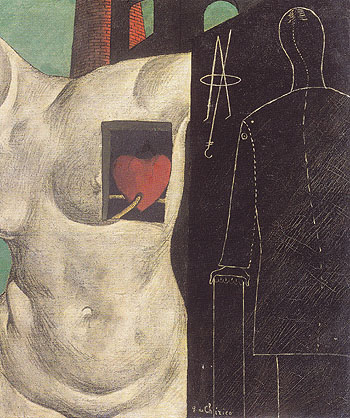
The Song of Love
Aspects like the strange grouping of objects in The Song of Love are what André Breton and the surrealists looked up to when organizing their movement.

